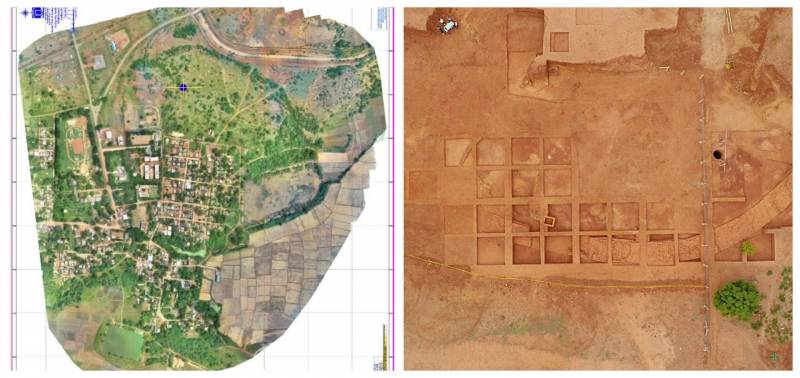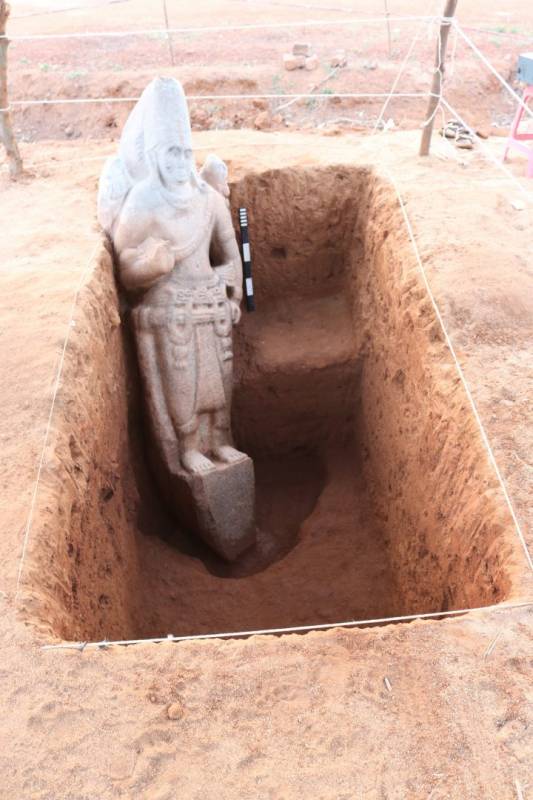ASI Excavations in Andhra Pradesh's Gottiprolu identify it as a trade centre
By Anurag Mallick
Gottiprolu: A team from the Archaeological Survey of India conducted excavations in Andhra Pradesh's Gottiprolu, identifying it as a trade centre of Early Historic Period. Excavations also unearthed a 2000-year-old brick structure and a Vishnu sculpture.
The first phase of excavation by the team, at the site near Naidupeta in Sri Potti Sriramulu Nellore district, discovered the remains of an extensive settlement surrounded by a massive brick enclosure. The most exciting discovery is that of an enormous brick enclosure wall at the southern part of the mound. The structure of baked bricks is exposed more than 75 metres with an average width of about 3.40 metres.

Another exciting find reveals a small rectangular brick tank exposed near the inner lining of the curved brick structure. The available brick sizes (43-48 centimetres) can be compared with the Satavahana/Ikshvaku period structures in the Krishna valley that is Amaravati and Nagarjunakonda.
Apart from the excavated remains, one of the significant finds was that of a buried Vishnu sculpture from the western part of the village. Subsequent excavations around the sculpture revealed it a life-size image of Vishnu measuring about 2 metres in height. Iconographical features like the elaborate headgear, thick holy thread and decorative drapery date the Vishnu idol back to Pallava period. The other exciting antiquity retrieved is that of a moulded female terracotta figurine with two hands lifted upwards.

Apart from these, they found bases of conical jars placed at the Eastern side of the structure are widely distributed in Tamil Nadu and considered an imitated variety of Roman Amphorae jars. These settlements could have been an important Gottiprolu excavation trade centre as indicated by the presence of imitated amphorae wares that were mostly used to transport liquid commodities.
Further excavations revealed a series of broken terracotta pipes fitted into one another, which explained about the civic amenities maintained by the occupants of this site. Findings of assorted stone tools of Palaeolithic and Neolithic periods from secondary contexts suggest that prehistoric people had occupied this area. Studies are being carried out through geographical and chemical analysis of the site and samples.
The proximity of the site to the seacoast suggests that the area could have served as a strategic settlement involved in maritime trade. Other significant antiquities unearthed are copper and lead coins, iron spearheads, stone celts, terracotta beads, ear stud in semi-precious stone and hopscotches.
Explorations conducted in and around Gottiprolu within a radius of 15 kilometres revealed important vestiges such as fortified early historic settlement at Puduru, Sunbrahmanya temple at Mallam, unique rock-cut laterite stepped well at Yakasiri and Vishnu temple at Tirumuru.
The image displays a 4-armed Vishnu standing over a pedestal carrying chakra and conch in his upper right and left hands. The lower right is in bestowing boon and the left hand in katihastha (resting on the hip) posture. pic.twitter.com/fwO6EjuXRo
— Archaeological Survey of India (@ASIGoI) October 31, 2019
The two fortified townships within the gap of 15 km during the early historic times indicate that early historical people preferred the significant strategic location for trade in the region keeping because of the sea, river and lake.